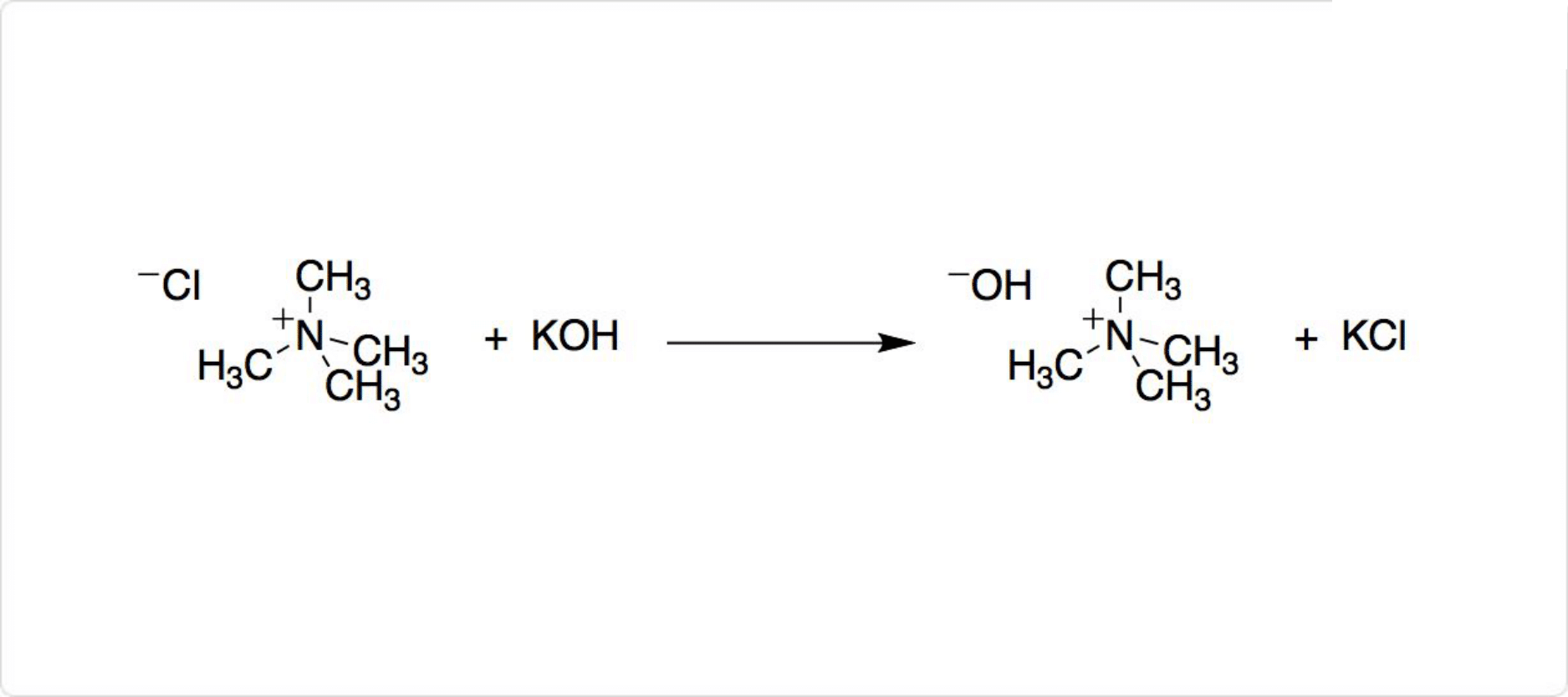テトラメチルアンモニウムヒドロキシド 化学特性,用途語,生産方法
外観
無色~うすい黄色透明液体
外観
無色~ほとんど無色透明液体
性質
テトラメチルアンモニウムヒドロキシドの無水物は、単離されていません。一般的には、安定した固体の五水和物の(CH3)4NOH・5H2Oや三水和物の(CH3)4NOH・3H2Oとして扱われます。2%や25%の水溶液やメタノール溶液も流通しています。
テトラメチルアンモニウムヒドロキシドの固体や水溶液は無色です。水溶液は強塩基性を示します。五水和物の融点は67°Cで、135〜140°Cで分解します。
解説
テトラメチルアンモニウムヒドロキシドとは、化学式(CH3)4NOHで表される、最も代表的な第四級アンモニウム塩の1つです。
化学物質審査規制法 (化審法) では、「優先評価化学物質」、環境基本法では「水質要調査項目」、毒劇法では「毒物」に指定されています。神経や筋肉に影響を及ぼし、致死的な呼吸困難や筋肉麻痺を起こします。そのため、皮膚に触れた場合には、強塩基性による化学火傷とともに、神経毒性があるため、注意が必要です。
用途
相間移動触媒、ポジレジスト現像液、エッチング剤、洗浄剤
構造
テトラメチルアンモニウムヒドロキシドのモル質量は91.15g/molです。テトラメチルアンモニウムイオン ((CH3)4N+) と水酸化物イオン (OH-) から構成されています。
別称に、TMAH、TMAOH、TMNOH、N,N,N-トリメチルメタンアミニウム・ヒドロキシド、水酸化テトラメチルアンモニウム、AZ-726、メガポシトCD14、ミクロポシトCD26、トクソSD20があります。
合成

図2. テトラメチルアンモニウムヒドロキシドの合成
最も古いテトラメチルアンモニウムヒドロキシドの製造法は、無水メタノール中で塩化テトラメチルアンモニウムと水酸化カリウムを混ぜる方法です。この苛性アルカリ分解法は現在でも一般的に使用されますが、塩素イオンやカリウムイオンが5,000ppm程度混入します。
陽イオン交換膜を用いた塩化テトラメチルアンモニウムの電気分解法は品質が高く、金属イオンが0.1ppm以下で、塩素イオンが10ppm以下になります。それ以外にも、シュウ酸塩、ギ酸塩、メチル炭酸塩のような有機酸テトラメチルアンモニウム塩水溶液を電気分解して生成可能です。
そのほか、塩化テトラメチルアンモニウムを硫酸によって硫酸塩にして、水酸化バリウムで処理すると得られます。
説明
Tetramethylammonium hydroxide is a solid in the hydrated form or a colorless liquid with a strong ammonia-like odor. It is soluble in water, and corrosive to metals and tissue.
化学的特性
colourless to yellow liquid
使用
Tetramethylammonium hydroxide is used to produce tetramethyl-ammonium azide. It is used as an anisotropic etchant of silicon, basic solvent in the development of acidic photoresist in photolithography process, as surfactant in the synthesis of ferrofluid and as a polarographic reagent. It finds application in the production of organic silicon, where it is used for computer silicon wafer surface brightener and cleaning agent. It is also involved in the purification of some metallic elements.
Tetramethylammonium hydroxide solution (25 wt.% solution in water) may be used as a base for pH adjustment to obtain hexagonal mesoporous aluminophosphate (TAP).
一般的な説明
Tetramethylammonium hydroxide is a quaternary ammonium salt generally used as an anisotropic etchant for silicon due to its high silicon etching rate.
反応プロフィール
Tetramethylammonium hydroxide acts like a base. Bases are chemically similar to sodium hydroxide (NaOH) or sodium oxide (Na2O). They neutralize acids exothermically to form salts plus water. When soluble in water they give solutions having a pH greater than 7.0. Mixing these materials with water can generate troublesome amounts of heat as the base is dissolved or diluted. Bases react with certain metals (such as aluminum and zinc) to form oxides or hydroxides of the metal and generate gaseous hydrogen. Bases may initiate polymerization reactions in polymerizable organic compounds, especially epoxides). They may generate flammable and/or toxic gases with ammonium salts, nitrides, halogenated organics, various metals, peroxides, and hydroperoxides. Materials of this group often serve as catalysts.
健康ハザード
TOXIC; inhalation, ingestion or skin contact with material may cause severe injury or death. Contact with molten substance may cause severe burns to skin and eyes. Avoid any skin contact. Effects of contact or inhalation may be delayed. Fire may produce irritating, corrosive and/or toxic gases. Runoff from fire control or dilution water may be corrosive and/or toxic and cause pollution.
火災危険
Combustible material: may burn but does not ignite readily. When heated, vapors may form explosive mixtures with air: indoors, outdoors and sewers explosion hazards. Contact with metals may evolve flammable hydrogen gas. Containers may explode when heated. Runoff may pollute waterways. Substance may be transported in a molten form.
関連する反応
テトラメチルアンモニウムヒドロキシドの反応

図3. テトラメチルアンモニウムヒドロキシドの反応
強酸や弱酸によってテトラメチルアンモニウムヒドロキシドは、酸塩基反応が起こって酸の陰イオンと交換します。メタセシス反応を用いて、さまざまなテトラメチルアンモニウム塩を生成可能です。
具体的には、チオシアン酸アンモニウムからチオシアン酸テトラメチルアンモニウムが得られます。生成する水とアンモニアを蒸発除去すると反応が進みます。
テトラメチルアンモニウムヒドロキシドの水溶液を減圧濃縮すると、五水和物の針状結晶を生成可能です。脱水濃縮を続けると、三水和物を経由して一水和物になり、135〜140℃でジトリメチルアミンやメチルエーテルに分解します。
参考文献
使用用途
テトラメチルアンモニウムヒドロキシドは試薬・触媒をはじめ、半導体・印刷などの分野で、幅広く用いられます。また、相間移動触媒、重合・縮合反応の触媒、有機窒素化合物製造の触媒、ガスクロマトグラフィー前処理剤、合成などの有機構造規定剤に使用可能です。
さらに、工業用途として、写真・印刷薬品、集積回路用ポジフォトレジスト現像液・エッチング剤・洗浄剤、粘土の解膠剤、繊維の表面処理剤、二次電池用アルカリ電解質に用いられます。
安全性プロファイル
Poison by subcutaneous route. A powerful caustic. A corrosive irritant to skin, eyes, and mucous membranes. When heated to decomposition it emits toxic fumes of NOx and NH3.
純化方法
It is freed from chloride ions by passage through an ion-exchange column (e.g. Amberlite IRA-400, prepared in its OH-form by passing 2M NaOH until the effluent is free from chloride ions, then washed with distilled H2O until neutral). A modification, to obtain carbonate-free hydroxide, uses the method of Davies and Nancollas [Nature 165 237 1950]. [Beilstein 4 IV 145.]
参考文献
1.https://en.wikipedia.org/wiki/Tetramethylammonium_hydroxide#Uses
2.http://sacheminc.com/other-chemicals/tetramethylammonium-hydroxide-tmah/
3.https://www.fs.usda.gov/treesearch/pubs/15506
4.https://www.concordia.ca/content/dam/concordia/services/safety/docs/EHS-DOC-020_TMAHGuidelines.pdf
5.https://www.chemicalbook.com/ChemicalProductProperty_EN_CB2854236.htm
テトラメチルアンモニウムヒドロキシド 上流と下流の製品情報
原材料
準備製品